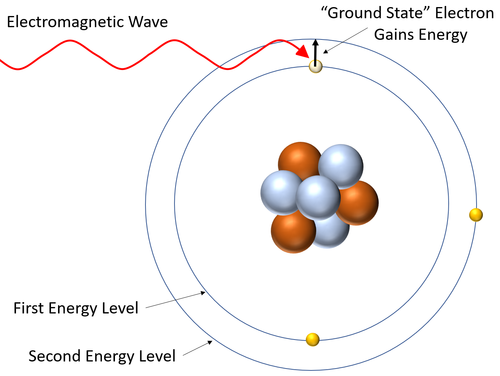Difference between revisions of "Absorption Spectra"
(→References) |
|||
| (2 intermediate revisions by one other user not shown) | |||
| Line 20: | Line 20: | ||
===References=== | ===References=== | ||
====AQA==== | ====AQA==== | ||
| − | :[https://www.amazon.co.uk/gp/product/0008158770/ref=as_li_tl?ie=UTF8&camp=1634&creative=6738&creativeASIN=0008158770&linkCode=as2&tag=nrjc-21&linkId=ec31595e720e1529e49876c3866fff6e ''Absorption; lines, page 111, GCSE Physics; Student Book, Collins, AQA'] | + | :[https://www.amazon.co.uk/gp/product/0008158770/ref=as_li_tl?ie=UTF8&camp=1634&creative=6738&creativeASIN=0008158770&linkCode=as2&tag=nrjc-21&linkId=ec31595e720e1529e49876c3866fff6e ''Absorption; lines, page 111, GCSE Physics; Student Book, Collins, AQA''] |
| + | |||
| + | ====Edexcel==== | ||
| + | :[https://www.amazon.co.uk/gp/product/1782948163/ref=as_li_tl?ie=UTF8&camp=1634&creative=6738&creativeASIN=1782948163&linkCode=as2&tag=nrjc-21&linkId=0fdbfd5dd397d6e24a9dfb250f08587f ''Absorption spectra, pages 191, 192, GCSE Physics, CGP, Edexcel ''] | ||
| + | :[https://www.amazon.co.uk/gp/product/1292120193/ref=as_li_tl?ie=UTF8&camp=1634&creative=6738&creativeASIN=1292120193&linkCode=as2&tag=nrjc-21&linkId=572df39392fb4200db8391d98ae6314e ''Absorption spectrum, page 359, GCSE Combined Science, Pearson Edexcel ''] | ||
| + | :[https://www.amazon.co.uk/gp/product/1292120223/ref=as_li_tl?ie=UTF8&camp=1634&creative=6738&creativeASIN=1292120223&linkCode=as2&tag=nrjc-21&linkId=068ecf40278c32406a7f1c6e66751417 ''Absorption spectrum, page 95, GCSE Physics, Pearson Edexcel ''] | ||
| + | |||
| + | ====OCR==== | ||
| + | |||
| + | :[https://www.amazon.co.uk/gp/product/0198359837/ref=as_li_tl?ie=UTF8&camp=1634&creative=6738&creativeASIN=0198359837&linkCode=as2&tag=nrjc-21&linkId=3c4229e8b023b2b60768e7ea2307cc6f ''Absorption spectrum, pages 178-179, Gateway GCSE Physics, Oxford, OCR ''] | ||
Latest revision as of 10:06, 30 November 2019
Contents
Key Stage 4
Meaning
Absorption spectra are the specific wavelengths of light absorbed by the electrons in atoms as they gain energy.
About Absorption Spectra
- An absorption spectrum is made by passing white light through a material or reflecting it off a material then sending it through a prism to separate the colours.
- The spectrum of white light is a continuous change of colours with all wavelengths having the same intensity.
- An absorption spectrum is a set of specific wavelengths with a low intensity. This appears as dark lines of of missing colour from the normal spectrum made by white light.
- A absorption spectrum is created when electrons absorb the energy from an electromagnetic wave and jump to a higher energy level in an atom. This removes that particular wavelength of electromagnetic wave white light being transmitted or reflected from that material.
- The wavelengths of electromagnetic wave depend on the energy difference between the energy levels in atoms.
| This diagram shows an electron gaining energy by absorbing an electromagnetic wave and becoming excited (moving to a higher energy level). |
References
AQA
Edexcel
- Absorption spectra, pages 191, 192, GCSE Physics, CGP, Edexcel
- Absorption spectrum, page 359, GCSE Combined Science, Pearson Edexcel
- Absorption spectrum, page 95, GCSE Physics, Pearson Edexcel

